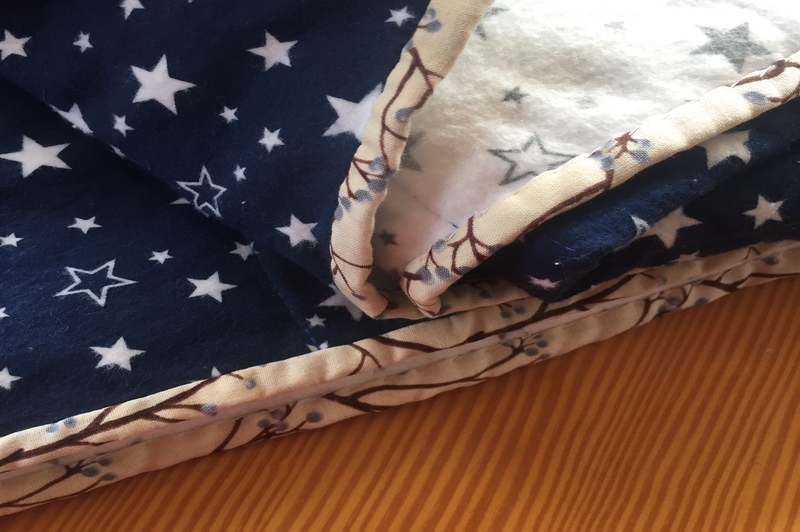Weighted blankets can come in different sizes, and while many would love to own them, not everyone knows how to wash a weighted blanket with glass beads or other weighted materials.

Weighted blankets should be washed three to four times a year, so if you haven’t tried cleaning yours yet, here are some things to take into account when washing weighted blankets.
Steps On How To Wash A Weighted Blanket With Glass Beads
Step #1. Pretreating
Inspect your blanket thoroughly for stains. You will have to pre-treat these stains before washing to prevent them from baking into the fabric during the washing and drying process.
Check for tears and damages, as well. If you find any, mend the tear before putting the blanket in the washing machine to prevent further damage.
Step #2. Hand washing
You may machine wash your weighted blanket, but you will have to consider its weight and size to ensure that it won’t be too heavy for your machine. Instead, opt to hand wash your weighted blanket to minimize wear and tear.
Use a mild detergent and avoid using harsh chemicals such as bleach to be abrasive to the fabric. Do not forget to check what type of fabric your weighted blanket is made of.
Each material can differ in laundry instructions. It is best to follow the manufacturer’s instructions as they know how to care for their products.
Step #3. Air drying
Check the material in your weighted blanket. While glass beads are safe for dryers, poly pellet fillers tend to melt, so you should avoid using higher temperatures when drying them.
To be safe, opt to hang your weighted blanket instead. Hang the blanket evenly over your clothesline so that it will maintain its shape.
Give it a little shake now and then so that you can redistribute the fillers as well.
Step #4. Ironing
As mentioned above, many weighted blanket materials could melt under intense heat, so avoid ironing your weighted blanket. Doing so will cause the blanket to shrink or melt the plastic inside.
To hide unsightly wrinkles, you may opt to put a cover over the weighted blanket instead.
What Factors Do You Need To Consider When Washing Your Weighted Blanket?
Make sure that you purchase a washable weighted blanket with poly pellets, glass beads, or shot fillers. While organic materials are excellent for other products, they are not the best option for weighted blankets as they will decompose when they get wet – which could also result in molds.
Weighted blankets usually come with cleaning instructions from the manufacturers since they know their products best. However, if you can’t find your blanket’s instructions, here are some things you need to consider when washing.
- Fabric – There are different washing instructions for different types of fabrics. For instance, cotton and flannel are relatively easy to hand or machine wash, but wool is prone to shrinking, so it should only be hand washed if possible.
- Fillers – You will also have to consider the fillers inside the weighted blanket because plastic poly pellets should not be exposed to high temperatures. At the same time, sand should not be washed often to avoid clumps and uneven drying that could cause uneven weight distribution.
It would be best if you were careful when cleaning rice, beans, or organic fillers as they could turn soggy when exposed to water.
- Weight – The blanket’s weight should also be considered when washing as they could be too heavy for the maximum load for your washing machine.
If you insist on machine washing your weighted blanket, you may want to look for commercial-sized washing machines that could handle laundry above 20 pounds in weight.
- Blanket cover – Blanket covers are lighter than the inner duvet, so you can easily hand wash them or toss them in the washing machine. However, you will have to consider the material that the blanket cover is made of to avoid damage to the fabric.
How Do You Keep Your Weighted Blanket Clean?
Weighted blankets should be washed three to four times a year, but sometimes you will have to clean them more often, especially if there are stains, dust, or musty odors present.
Frequent machine washing can increase wear and tear and affect the blanket’s softness, so you should take care to keep it as clean as possible instead.
-
Do not allow pets to sleep in bed with you
They can shed or leave dirty paw prints on the blanket. They can also cause odor or smells on the blanket. Instead, provide your pets with separate, washable sheets where they can sleep.
-
Avoid eating in bed
Having meals in bed could cause stains on your blanket if you are not careful. The smell of food also tends to linger on the fabric, and you do not want your blanket to smell like food most of the time.
-
Use a removable cover
Removable covers will protect your blanket from most stains and smells, so you will not have to wash your weighted blanket often. Moreover, a removable cover is easier to clean and much cheaper to replace.
Conclusion
There are plenty of benefits to using weighted blankets. However, you have to take special care of them if you want them to last long in your possession.
If you don’t know how to wash a weighted blanket with glass beads or other non-organic materials inside, it is best to refer to the manufacturer’s washing instructions because they know what’s best for the item.
